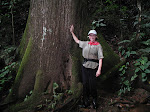Some three thousand horses and a human multitude converged downtown San Jose yesterday for the famous National Tope. I, however, kept my horses peacefully out to pasture and joined a small group of Ciudad Colon neighbors to take presents and clothing out to the nearby Quitirrisi Indigenous Reserve. Our group was organized by the local English/Spanish teacher, Roxana Vega, who is known for her joyful high spirits and compassion for others. There are many needs in this country and she is kept busy year round, always finding a new batch of volunteers whenever students from the University of Peace contact her for Spanish lessons. What better way to learn Spanish than to immerse yourself into the culture and volunteer?
So yesterday, a caravan of cars followed Roxana’s white pickup, all piled high with boxes of new clothing, out to the Reserve, located about 10 minutes west of Ciudad Colon. We were met by the village elder, Juan Sanchez, who calls himself Chotto in the Huetar language. He led us down a beautiful wooded trail to the village square, anchored by a lovely round bamboo structure, which felt fresh and cool inside. We soon discovered that Juan – Chotto is also the village shaman and uses the structure for curing ailments. In reality, the large, interior area is both called “Centro de Curacion el Coicote” and also, “Templo de Las Creencias Indígenas Huetar, Tatamama”. He took us around and showed us some of his remedies – mixtures of bones – ancient stones – dried seeds - all of which he uses along with herbs and invocations to the spirit world to effect the cure.
While Chotto was showing us some of his implements of the healing arts, the square outside filled with indigenous people, who walked in from all over. Most of the volunteers moved outside to help distribute the gifts. It was a big, noisy, joyous occasion.
We stayed out of the sun and sat down on a bench with Chotto to talk with him about his people. Choto learned the Huetar traditions from his father and passes them down to his children. The Huetar were once the most organized and powerful indigenous group in Costa Rica, as they inhabited the fertile, central valley plateau, known as the land of eternal spring. Unfortunately for the Huetar, the Spaniards agreed with them that this was the most pleasant location for settling in the country and pushed the Huetar out. They are now confined to a small reserve to the west of the valley, which they named Quitirrisi (this means the names of two trees: Quitiri and Risi).
The Spaniards effectively stamped out Huetar traditions and, except for some words, which one recognizes from many of the town names in the Central Valley, the spoken Huetar language is lost. Chotto explained that other indigenous groups in Costa Rica, such as the Bribri have had more luck retaining their language because they are located in more remote areas. The Costa Ricans, through influence from the church, even tried to rename Quitirrisi to “San Martin” but the indigenous would have none of it.
Today, the people are healthy and live simple lives. They have smiling, laughing children and well-fed, contented dogs. They make well-crafted baskets and hammocks, which they offer for sale on the main road to Puriscal. Some of the adults work at jobs in the Central Valley and the kids go to school in Ciudad Colon. Choto worries about retaining the indigenous traditions when the modern world interfaces in so many ways. Some of his people now go to the medical clinic rather than requesting traditional cures, although he admits that all come to him in the end if the western medicine doesn’t work.
From what I understood of what Chotto described, the Huetar style of medicine isn’t so much as one remedy but the combination of earth/sun/moon energies that he tries to align, using representations (like plant cut at 1st day new moon) in order to bring the cure. You need to feel the energy and believe in its power. Sounds more powerful than the placebo effect and the placebo effect is very powerful!
I was very interested in his vast knowledge of trees and plants but there was no time left for talk – it was time to go join the festivities outside. But Chotto did promise he would come visit us at Finca El Tigre. He knows the forest and said that we have some rare plants that he could use at the reserve. We agreed to do some trading of seeds, etc and discussing more of the traditions.
I hope to share more about the Huetar traditions with you very soon!
Saludos a todos y pura vida!
Subscribe to:
Post Comments (Atom)


No comments:
Post a Comment